Project Costing and Financial Management Report - Analysis
VerifiedAdded on 2023/01/10
|7
|1416
|75
Report
AI Summary
This report delves into the core concepts of project costing and financial management. It begins by defining and differentiating between tangible and intangible costs, fixed, direct, and indirect costs. The report explains cost baseline and cost variances, including the roles of management and contingency reserves. It then explores two project funding sources: commercial loans and bridge financing, assessing their advantages and disadvantages. Risk management strategies, particularly risk transfer techniques like insurance and contractual agreements, are discussed. Finally, the report examines project cost control, its importance, common organizational challenges, and potential solutions, such as project planning and cost estimation. The report provides a comprehensive overview of key elements in project financial planning and execution.
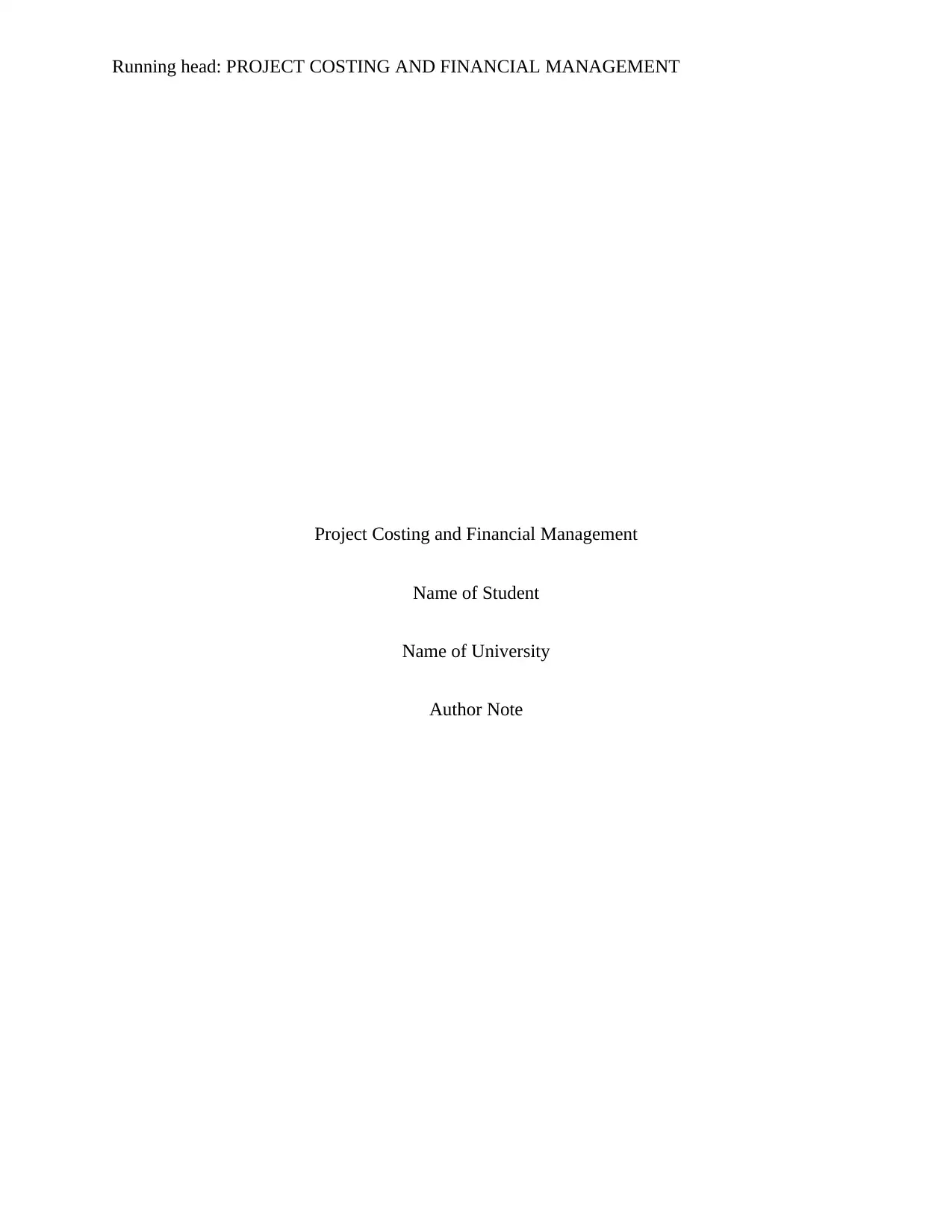
Running head: PROJECT COSTING AND FINANCIAL MANAGEMENT
Project Costing and Financial Management
Name of Student
Name of University
Author Note
Project Costing and Financial Management
Name of Student
Name of University
Author Note
Paraphrase This Document
Need a fresh take? Get an instant paraphrase of this document with our AI Paraphraser
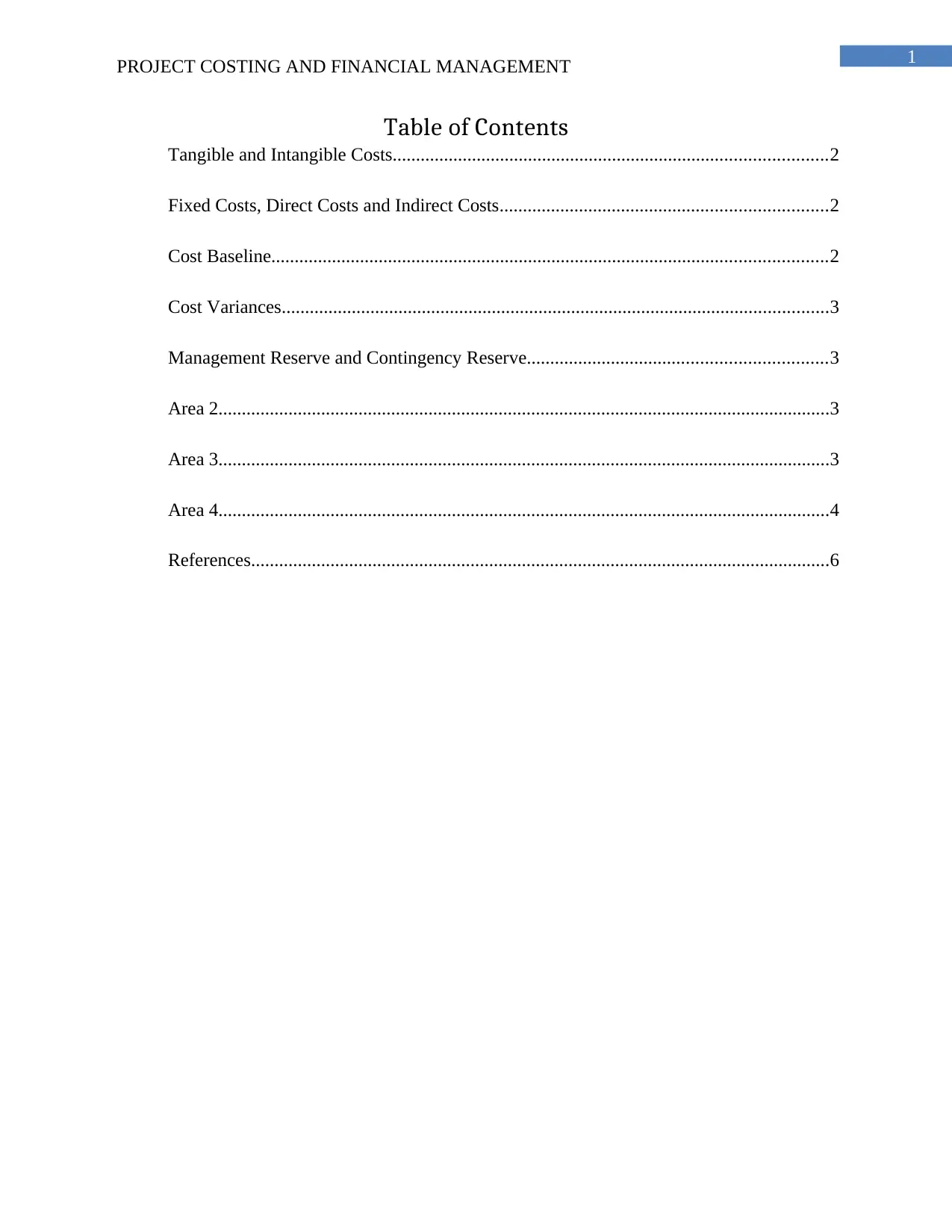
1
PROJECT COSTING AND FINANCIAL MANAGEMENT
Table of Contents
Tangible and Intangible Costs.............................................................................................2
Fixed Costs, Direct Costs and Indirect Costs......................................................................2
Cost Baseline.......................................................................................................................2
Cost Variances.....................................................................................................................3
Management Reserve and Contingency Reserve................................................................3
Area 2...................................................................................................................................3
Area 3...................................................................................................................................3
Area 4...................................................................................................................................4
References............................................................................................................................6
PROJECT COSTING AND FINANCIAL MANAGEMENT
Table of Contents
Tangible and Intangible Costs.............................................................................................2
Fixed Costs, Direct Costs and Indirect Costs......................................................................2
Cost Baseline.......................................................................................................................2
Cost Variances.....................................................................................................................3
Management Reserve and Contingency Reserve................................................................3
Area 2...................................................................................................................................3
Area 3...................................................................................................................................3
Area 4...................................................................................................................................4
References............................................................................................................................6
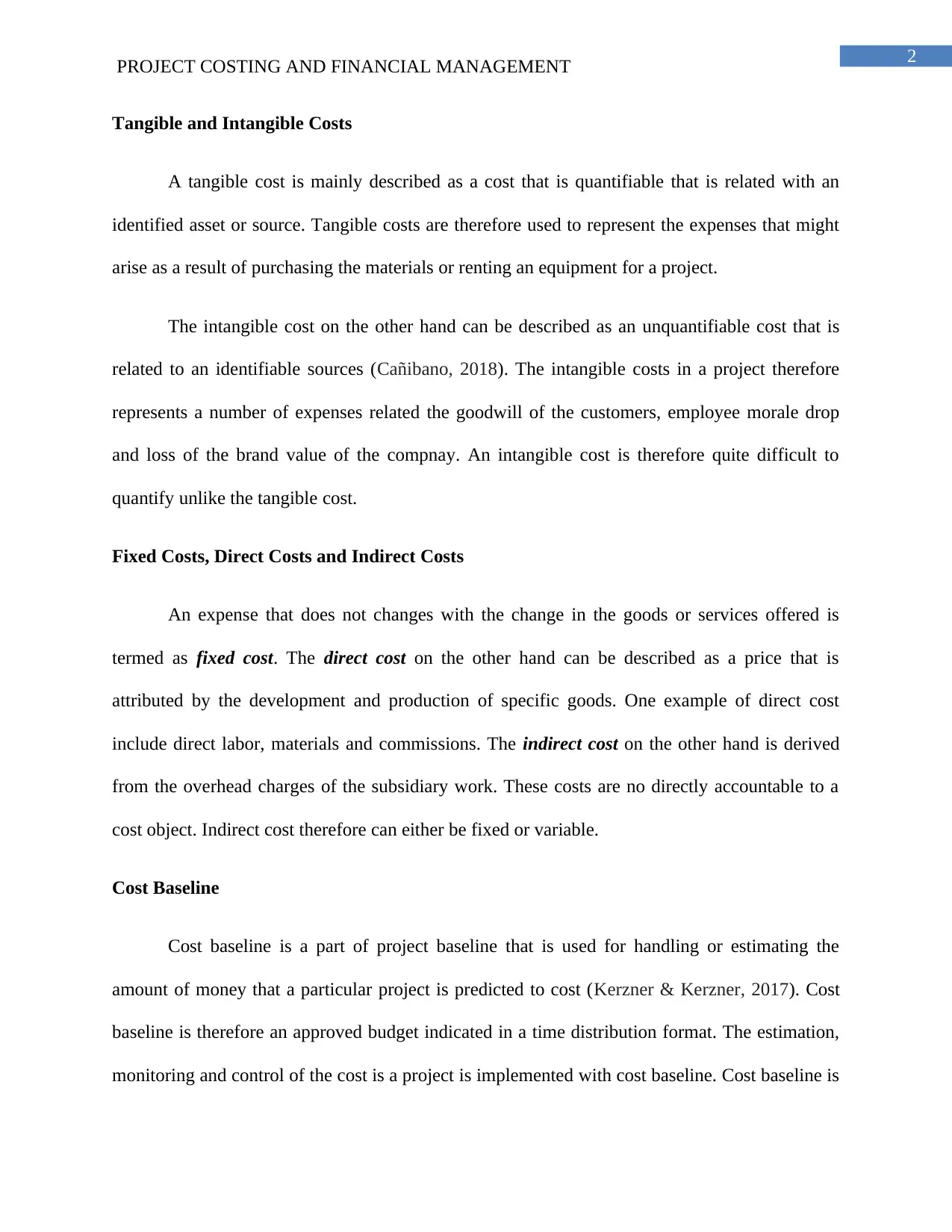
2
PROJECT COSTING AND FINANCIAL MANAGEMENT
Tangible and Intangible Costs
A tangible cost is mainly described as a cost that is quantifiable that is related with an
identified asset or source. Tangible costs are therefore used to represent the expenses that might
arise as a result of purchasing the materials or renting an equipment for a project.
The intangible cost on the other hand can be described as an unquantifiable cost that is
related to an identifiable sources (Cañibano, 2018). The intangible costs in a project therefore
represents a number of expenses related the goodwill of the customers, employee morale drop
and loss of the brand value of the compnay. An intangible cost is therefore quite difficult to
quantify unlike the tangible cost.
Fixed Costs, Direct Costs and Indirect Costs
An expense that does not changes with the change in the goods or services offered is
termed as fixed cost. The direct cost on the other hand can be described as a price that is
attributed by the development and production of specific goods. One example of direct cost
include direct labor, materials and commissions. The indirect cost on the other hand is derived
from the overhead charges of the subsidiary work. These costs are no directly accountable to a
cost object. Indirect cost therefore can either be fixed or variable.
Cost Baseline
Cost baseline is a part of project baseline that is used for handling or estimating the
amount of money that a particular project is predicted to cost (Kerzner & Kerzner, 2017). Cost
baseline is therefore an approved budget indicated in a time distribution format. The estimation,
monitoring and control of the cost is a project is implemented with cost baseline. Cost baseline is
PROJECT COSTING AND FINANCIAL MANAGEMENT
Tangible and Intangible Costs
A tangible cost is mainly described as a cost that is quantifiable that is related with an
identified asset or source. Tangible costs are therefore used to represent the expenses that might
arise as a result of purchasing the materials or renting an equipment for a project.
The intangible cost on the other hand can be described as an unquantifiable cost that is
related to an identifiable sources (Cañibano, 2018). The intangible costs in a project therefore
represents a number of expenses related the goodwill of the customers, employee morale drop
and loss of the brand value of the compnay. An intangible cost is therefore quite difficult to
quantify unlike the tangible cost.
Fixed Costs, Direct Costs and Indirect Costs
An expense that does not changes with the change in the goods or services offered is
termed as fixed cost. The direct cost on the other hand can be described as a price that is
attributed by the development and production of specific goods. One example of direct cost
include direct labor, materials and commissions. The indirect cost on the other hand is derived
from the overhead charges of the subsidiary work. These costs are no directly accountable to a
cost object. Indirect cost therefore can either be fixed or variable.
Cost Baseline
Cost baseline is a part of project baseline that is used for handling or estimating the
amount of money that a particular project is predicted to cost (Kerzner & Kerzner, 2017). Cost
baseline is therefore an approved budget indicated in a time distribution format. The estimation,
monitoring and control of the cost is a project is implemented with cost baseline. Cost baseline is
⊘ This is a preview!⊘
Do you want full access?
Subscribe today to unlock all pages.

Trusted by 1+ million students worldwide
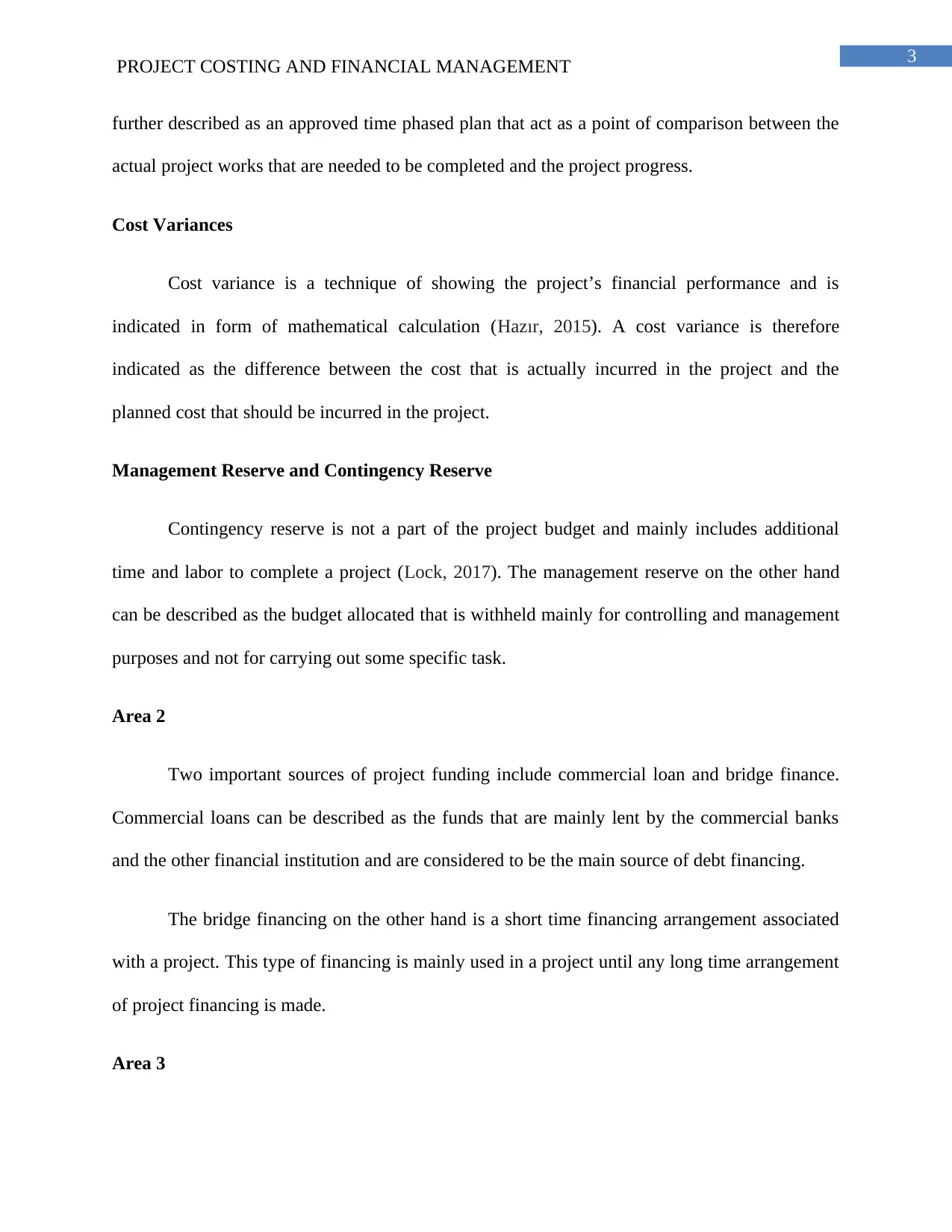
3
PROJECT COSTING AND FINANCIAL MANAGEMENT
further described as an approved time phased plan that act as a point of comparison between the
actual project works that are needed to be completed and the project progress.
Cost Variances
Cost variance is a technique of showing the project’s financial performance and is
indicated in form of mathematical calculation (Hazır, 2015). A cost variance is therefore
indicated as the difference between the cost that is actually incurred in the project and the
planned cost that should be incurred in the project.
Management Reserve and Contingency Reserve
Contingency reserve is not a part of the project budget and mainly includes additional
time and labor to complete a project (Lock, 2017). The management reserve on the other hand
can be described as the budget allocated that is withheld mainly for controlling and management
purposes and not for carrying out some specific task.
Area 2
Two important sources of project funding include commercial loan and bridge finance.
Commercial loans can be described as the funds that are mainly lent by the commercial banks
and the other financial institution and are considered to be the main source of debt financing.
The bridge financing on the other hand is a short time financing arrangement associated
with a project. This type of financing is mainly used in a project until any long time arrangement
of project financing is made.
Area 3
PROJECT COSTING AND FINANCIAL MANAGEMENT
further described as an approved time phased plan that act as a point of comparison between the
actual project works that are needed to be completed and the project progress.
Cost Variances
Cost variance is a technique of showing the project’s financial performance and is
indicated in form of mathematical calculation (Hazır, 2015). A cost variance is therefore
indicated as the difference between the cost that is actually incurred in the project and the
planned cost that should be incurred in the project.
Management Reserve and Contingency Reserve
Contingency reserve is not a part of the project budget and mainly includes additional
time and labor to complete a project (Lock, 2017). The management reserve on the other hand
can be described as the budget allocated that is withheld mainly for controlling and management
purposes and not for carrying out some specific task.
Area 2
Two important sources of project funding include commercial loan and bridge finance.
Commercial loans can be described as the funds that are mainly lent by the commercial banks
and the other financial institution and are considered to be the main source of debt financing.
The bridge financing on the other hand is a short time financing arrangement associated
with a project. This type of financing is mainly used in a project until any long time arrangement
of project financing is made.
Area 3
Paraphrase This Document
Need a fresh take? Get an instant paraphrase of this document with our AI Paraphraser
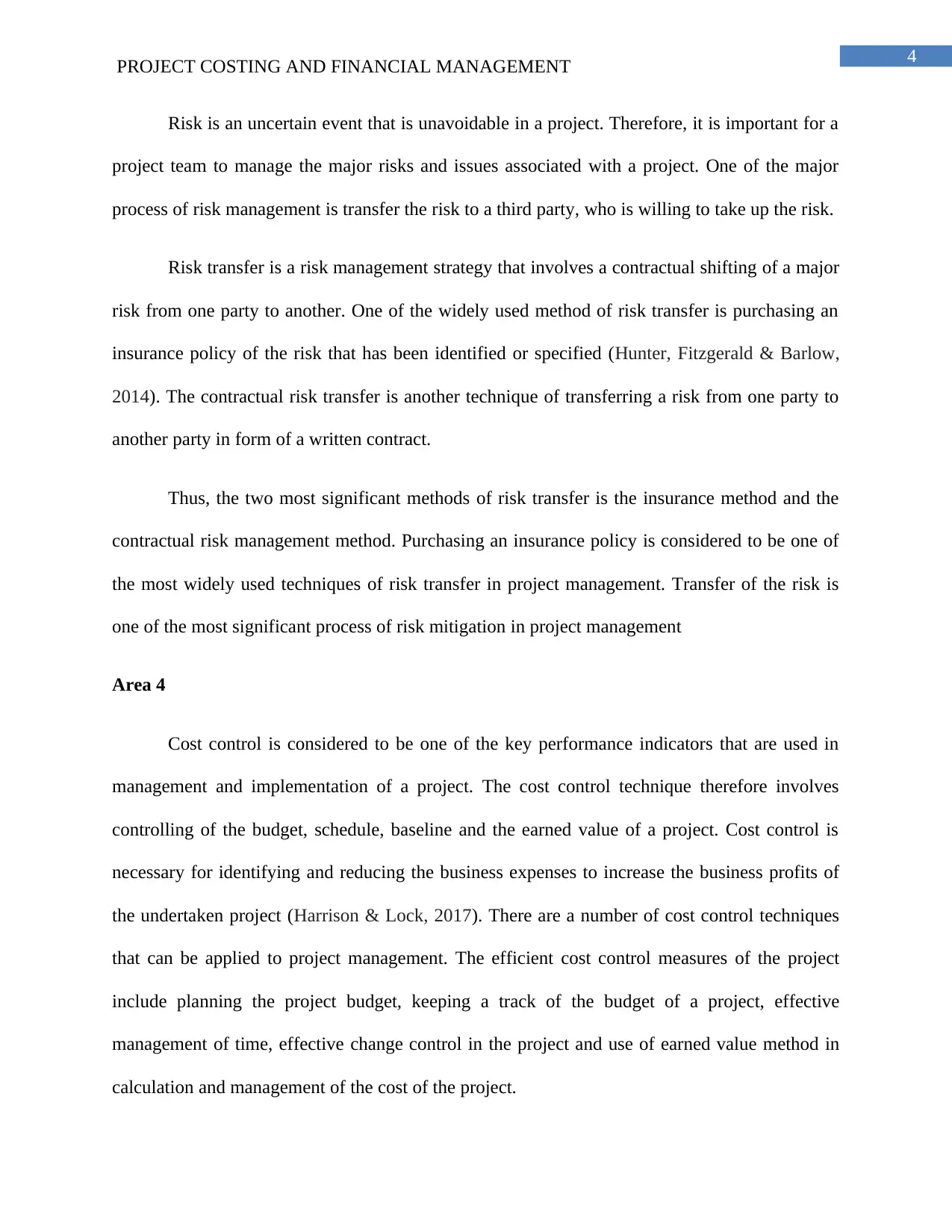
4
PROJECT COSTING AND FINANCIAL MANAGEMENT
Risk is an uncertain event that is unavoidable in a project. Therefore, it is important for a
project team to manage the major risks and issues associated with a project. One of the major
process of risk management is transfer the risk to a third party, who is willing to take up the risk.
Risk transfer is a risk management strategy that involves a contractual shifting of a major
risk from one party to another. One of the widely used method of risk transfer is purchasing an
insurance policy of the risk that has been identified or specified (Hunter, Fitzgerald & Barlow,
2014). The contractual risk transfer is another technique of transferring a risk from one party to
another party in form of a written contract.
Thus, the two most significant methods of risk transfer is the insurance method and the
contractual risk management method. Purchasing an insurance policy is considered to be one of
the most widely used techniques of risk transfer in project management. Transfer of the risk is
one of the most significant process of risk mitigation in project management
Area 4
Cost control is considered to be one of the key performance indicators that are used in
management and implementation of a project. The cost control technique therefore involves
controlling of the budget, schedule, baseline and the earned value of a project. Cost control is
necessary for identifying and reducing the business expenses to increase the business profits of
the undertaken project (Harrison & Lock, 2017). There are a number of cost control techniques
that can be applied to project management. The efficient cost control measures of the project
include planning the project budget, keeping a track of the budget of a project, effective
management of time, effective change control in the project and use of earned value method in
calculation and management of the cost of the project.
PROJECT COSTING AND FINANCIAL MANAGEMENT
Risk is an uncertain event that is unavoidable in a project. Therefore, it is important for a
project team to manage the major risks and issues associated with a project. One of the major
process of risk management is transfer the risk to a third party, who is willing to take up the risk.
Risk transfer is a risk management strategy that involves a contractual shifting of a major
risk from one party to another. One of the widely used method of risk transfer is purchasing an
insurance policy of the risk that has been identified or specified (Hunter, Fitzgerald & Barlow,
2014). The contractual risk transfer is another technique of transferring a risk from one party to
another party in form of a written contract.
Thus, the two most significant methods of risk transfer is the insurance method and the
contractual risk management method. Purchasing an insurance policy is considered to be one of
the most widely used techniques of risk transfer in project management. Transfer of the risk is
one of the most significant process of risk mitigation in project management
Area 4
Cost control is considered to be one of the key performance indicators that are used in
management and implementation of a project. The cost control technique therefore involves
controlling of the budget, schedule, baseline and the earned value of a project. Cost control is
necessary for identifying and reducing the business expenses to increase the business profits of
the undertaken project (Harrison & Lock, 2017). There are a number of cost control techniques
that can be applied to project management. The efficient cost control measures of the project
include planning the project budget, keeping a track of the budget of a project, effective
management of time, effective change control in the project and use of earned value method in
calculation and management of the cost of the project.
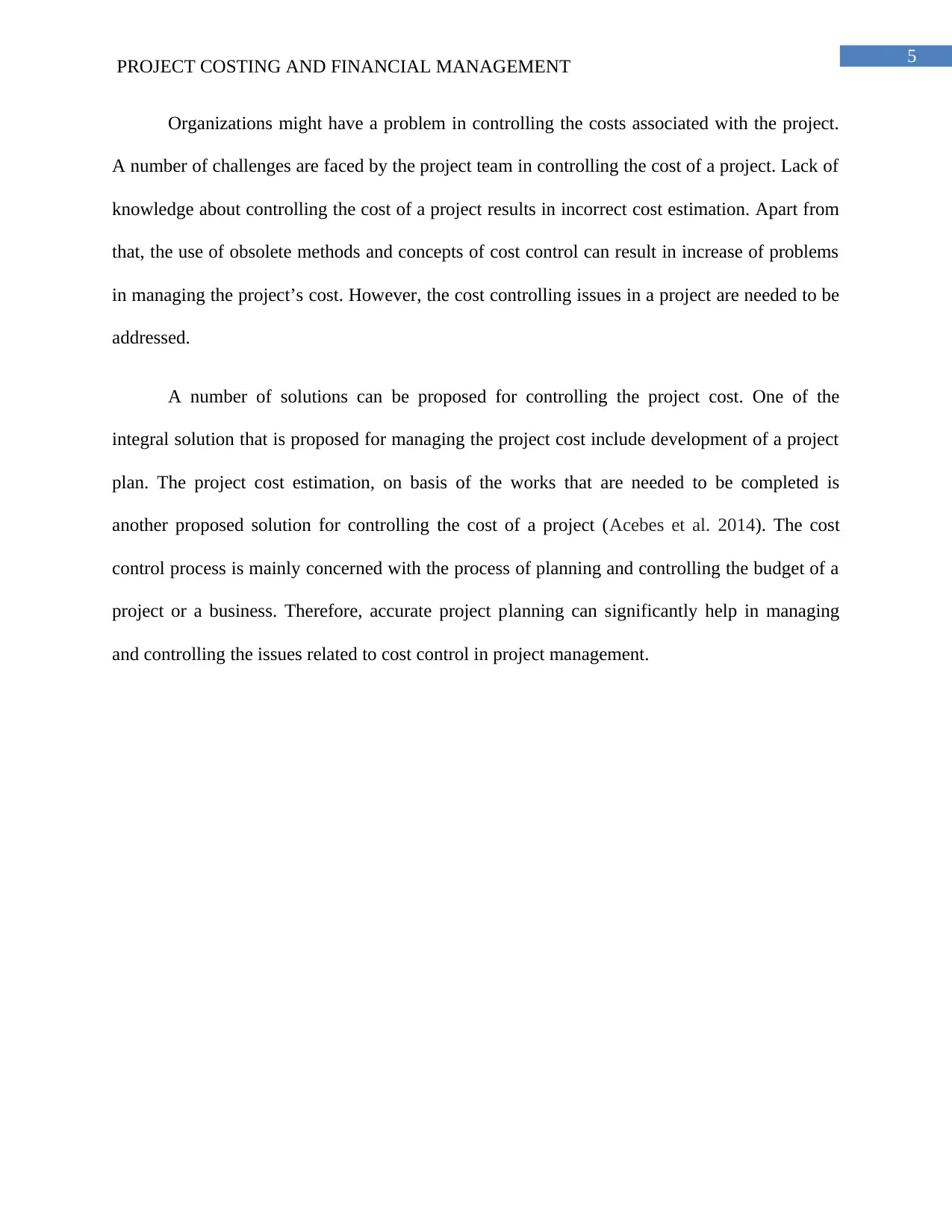
5
PROJECT COSTING AND FINANCIAL MANAGEMENT
Organizations might have a problem in controlling the costs associated with the project.
A number of challenges are faced by the project team in controlling the cost of a project. Lack of
knowledge about controlling the cost of a project results in incorrect cost estimation. Apart from
that, the use of obsolete methods and concepts of cost control can result in increase of problems
in managing the project’s cost. However, the cost controlling issues in a project are needed to be
addressed.
A number of solutions can be proposed for controlling the project cost. One of the
integral solution that is proposed for managing the project cost include development of a project
plan. The project cost estimation, on basis of the works that are needed to be completed is
another proposed solution for controlling the cost of a project (Acebes et al. 2014). The cost
control process is mainly concerned with the process of planning and controlling the budget of a
project or a business. Therefore, accurate project planning can significantly help in managing
and controlling the issues related to cost control in project management.
PROJECT COSTING AND FINANCIAL MANAGEMENT
Organizations might have a problem in controlling the costs associated with the project.
A number of challenges are faced by the project team in controlling the cost of a project. Lack of
knowledge about controlling the cost of a project results in incorrect cost estimation. Apart from
that, the use of obsolete methods and concepts of cost control can result in increase of problems
in managing the project’s cost. However, the cost controlling issues in a project are needed to be
addressed.
A number of solutions can be proposed for controlling the project cost. One of the
integral solution that is proposed for managing the project cost include development of a project
plan. The project cost estimation, on basis of the works that are needed to be completed is
another proposed solution for controlling the cost of a project (Acebes et al. 2014). The cost
control process is mainly concerned with the process of planning and controlling the budget of a
project or a business. Therefore, accurate project planning can significantly help in managing
and controlling the issues related to cost control in project management.
⊘ This is a preview!⊘
Do you want full access?
Subscribe today to unlock all pages.

Trusted by 1+ million students worldwide
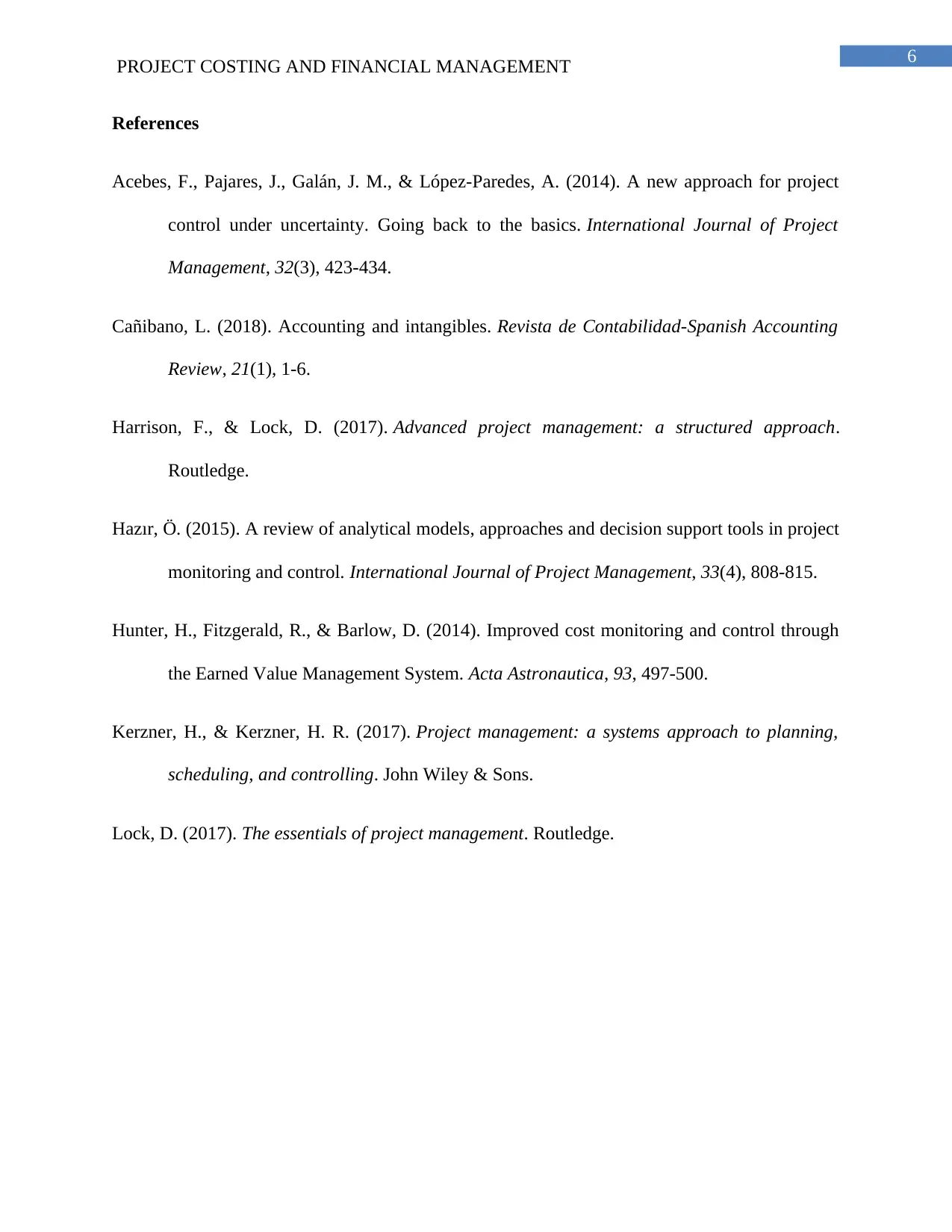
6
PROJECT COSTING AND FINANCIAL MANAGEMENT
References
Acebes, F., Pajares, J., Galán, J. M., & López-Paredes, A. (2014). A new approach for project
control under uncertainty. Going back to the basics. International Journal of Project
Management, 32(3), 423-434.
Cañibano, L. (2018). Accounting and intangibles. Revista de Contabilidad-Spanish Accounting
Review, 21(1), 1-6.
Harrison, F., & Lock, D. (2017). Advanced project management: a structured approach.
Routledge.
Hazır, Ö. (2015). A review of analytical models, approaches and decision support tools in project
monitoring and control. International Journal of Project Management, 33(4), 808-815.
Hunter, H., Fitzgerald, R., & Barlow, D. (2014). Improved cost monitoring and control through
the Earned Value Management System. Acta Astronautica, 93, 497-500.
Kerzner, H., & Kerzner, H. R. (2017). Project management: a systems approach to planning,
scheduling, and controlling. John Wiley & Sons.
Lock, D. (2017). The essentials of project management. Routledge.
PROJECT COSTING AND FINANCIAL MANAGEMENT
References
Acebes, F., Pajares, J., Galán, J. M., & López-Paredes, A. (2014). A new approach for project
control under uncertainty. Going back to the basics. International Journal of Project
Management, 32(3), 423-434.
Cañibano, L. (2018). Accounting and intangibles. Revista de Contabilidad-Spanish Accounting
Review, 21(1), 1-6.
Harrison, F., & Lock, D. (2017). Advanced project management: a structured approach.
Routledge.
Hazır, Ö. (2015). A review of analytical models, approaches and decision support tools in project
monitoring and control. International Journal of Project Management, 33(4), 808-815.
Hunter, H., Fitzgerald, R., & Barlow, D. (2014). Improved cost monitoring and control through
the Earned Value Management System. Acta Astronautica, 93, 497-500.
Kerzner, H., & Kerzner, H. R. (2017). Project management: a systems approach to planning,
scheduling, and controlling. John Wiley & Sons.
Lock, D. (2017). The essentials of project management. Routledge.
1 out of 7
Related Documents
Your All-in-One AI-Powered Toolkit for Academic Success.
+13062052269
info@desklib.com
Available 24*7 on WhatsApp / Email
![[object Object]](/_next/static/media/star-bottom.7253800d.svg)
Unlock your academic potential
Copyright © 2020–2025 A2Z Services. All Rights Reserved. Developed and managed by ZUCOL.





